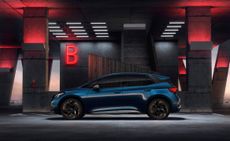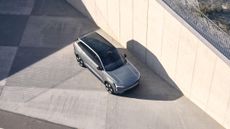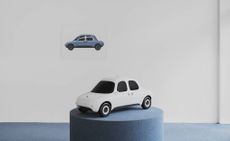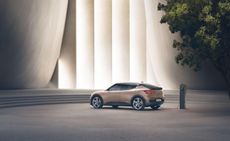The new Rolls-Royce Spectre glides into view
Rolls-Royce’s first-ever EV is a big moment for the brand. The Spectre retains the brand’s trademark sense of occasion and sheer physical scale without an exhaust pipe in sight
- (opens in new tab)
- (opens in new tab)
- (opens in new tab)
- Sign up to our newsletter Newsletter
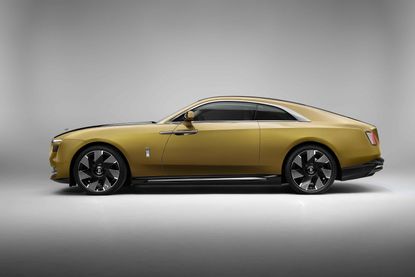
This is the Rolls-Royce Spectre, the famous marque’s first foray into building a pure electric vehicle. The Spectre has arrived fully formed and completely resolved, a monumental 5.4m long and 2m wide two-door, four-seater that marks the start of the company’s all-electric era.

Rolls-Royce has heritage. In fact, it can always be relied upon to dip into its 116-year history to find some relevant nugget that foreshadows its latest move. In Spectre’s case, it’s a 1900 statement by company co-founder Charles Rolls, in which he predicted the eventual domination of electric propulsion for cars.
Six years later, Rolls teamed up with Henry Royce to establish the company that bears their name. Four years after that, Rolls was dead, the first powered aviation fatality in the UK. Royce took the company forwards, rapidly establishing it as a benchmark for excellence, a name synonymous with the best in any given category.

Under BMW’s stewardship since 1998, Rolls-Royce has only had one previous visible foray into electrification. The Rolls-Royce 102EX, or Phantom Experimental Electric, was built in 2011 and toured the world, giving potential customers a taste of electrification.
With a range of just 125 miles and long before EV infrastructure was in place, the 102EX didn’t quite hit the spot. In Rolls-Royce’s world, spots are designed to be whacked right out of the ballpark, first time, so the engineering team bided its team.

Pre-production models of Spectre broke cover last year, but this is the first time the production-ready vehicle has been revealed.
Not due for delivery for at least 12 months, Spectre is due to slot into the space left by the departing Phantom Coupé. Crucially, it also means Rolls-Royce has a pure EV on the market some three years before Bentley.

Torsten Müller-Ötvös, Rolls-Royce Motor Cars’ CEO, describes Spectre as ‘the most perfect product that Rolls-Royce has ever produced’, a strong statement but one which aligns perfectly with current trends.
The company’s current fleet of models, from the Phantom (opens in new tab) to the Ghost (opens in new tab), and Cullinan (opens in new tab) stand apart from their peers by a steadfast refusal to engage with such vulgar things as power output, acceleration figures and top speed. Although massive V12 engines lurk beneath those equally massive bonnets, you would barely know and most buyers, it seems, barely care. That makes the brand especially well suited to electrification.

As you can see, the company’s design team has chosen not to do away with the massive bonnet, nor the towering radiator grille that fronts it.
This emphasis on form, not function, is what gives a Rolls-Royce its considerable aesthetic clout, and Spectre is no less imposing than any conventionally powered car bearing the famous Spirit of Ecstasy.

It also clocks in at a shade under 3 tonnes, making it by far the heaviest production car you can buy, despite making use of Rolls-Royce’s bespoke aluminium platform.
A massive battery pack probably accounts for most of the weight; the range has been upped to a more than respectable 323 miles. Surprisingly, the company has also thrown in an acceleration figure – 0-60mph in 4.4 seconds – to tempt those wealthy enthusiasts who are still on the fence.

The fastback bodywork recalls the form of the Wraith, to date the most avant-garde and sporting production Rolls-Royce of modern times (aside from the extraordinary creations of the Rolls-Royce Coachbuilt division (opens in new tab)). Inspiration is said to have been drawn from architecture and yacht design, with more emphasis on aerodynamics than ever before, right down to the wind-tunnel re-shaped Spirit of Ecstasy. Lighting, inside and out, has been taken up a notch, with LEDs within the stainless steel grille, concealed headlights and slender LED running lights.
To add to the unashamed and ‘imperious’ indicators of scale, the company claims that Spectre is ‘the first production two-door coupé to be equipped with 23-inch wheels in almost one hundred years’.

The lightshow continues inside, with the option of ‘Starlight Doors’, an extension of the company’s famed Starlight Headliner. The tiny pinpricks of light have now migrated to the door cards, with a grand total of 5,876 glittering stars transforming the interior.
You can even get the stars on the dash as well. At the core of the Spectre’s operation is Rolls-Royce’s new digital architecture, dubbed SPIRIT, a sort of butler-esque AI that works across the car’s interface and the RR ‘Whispers’ app to create a seamless relationship with the car; destinations, state of charge, and so on.

We’re atop the crest of another wave of retro car design, as the combination of EV innovation and consumer desire for familiarity and warmth sees carmakers plunder their heritage to splice the two together.
By 2030, every Rolls-Royce will be electric. The Spectre is the ghost of luxury car-making future.

INFORMATION
Rolls-Royce Spectre, first deliveries Q4 2023, price to be confirmed
rolls-roycemotorcars.com (opens in new tab)
Jonathan Bell has written for Wallpaper* magazine since 1999, covering everything from architecture and transport design to books, tech and graphic design. He is now the magazine’s Transport and Technology Editor. Jonathan has written and edited 15 books, including Concept Car Design, 21st Century House, and The New Modern House. He is also the host of Wallpaper’s first podcast.
-
 34th São Paulo Bienal arrives at Luma Arles for first European presentation
34th São Paulo Bienal arrives at Luma Arles for first European presentationAn exhibition of highlights from the 34th São Paulo Bienal is at Luma Arles, marking its European and tour finale
By Martha Elliott • Published
-
 This winter’s most stylish skiwear, Gucci to Hermès
This winter’s most stylish skiwear, Gucci to HermèsStatement-making skiwear for on and off the slopes, from Louis Vuitton, Dior, Moncler and more
By Jack Moss • Published
-
 Clásicos Mexicanos celebrates Mexican design’s golden age
Clásicos Mexicanos celebrates Mexican design’s golden ageDesign Miami 2022: the Maestro Dobel Artpothecary in collaboration with Clásicos Mexicanos features works from Mexican architect Ricardo Legorreta’s ‘Vallarta’ collection
By Sujata Burman • Published
-
 Everrati announces a transformed, all-electric Range Rover Classic and Land Rover Defender
Everrati announces a transformed, all-electric Range Rover Classic and Land Rover DefenderBritish company Everrati now transforms the iconic Range Rover Classic and Land Rover Defender into high-end, go-anywhere electric vehicles
By Jonathan Bell • Published
-
 Cupra Born: new arrival is one of the best compact EVs on the market
Cupra Born: new arrival is one of the best compact EVs on the marketThe new Cupra Born embodies characterful design and the spirited zip of electric driving
By Jonathan Bell • Published
-
 Two new electric off-roaders – Munro Mk1 and Fering Pioneer – embody the spirit of adventure in sharp-edged, minimal suits
Two new electric off-roaders – Munro Mk1 and Fering Pioneer – embody the spirit of adventure in sharp-edged, minimal suitsThe Munro Mk1 and Fering Pioneer are designed to go anywhere, electrically. We check out the next generation of utility vehicles
By Jonathan Bell • Last updated
-
 Kia Niro EV combines quiet competence with engaging modern design
Kia Niro EV combines quiet competence with engaging modern designThe Kia Niro EV sets a new standard for compact electric cars, with sophisticated design, impressive range and plenty of equipment
By Jonathan Bell • Published
-
 Revived cult classic all-electric Moke makes it to the States
Revived cult classic all-electric Moke makes it to the StatesAn all-new electric version of the original Mini Moke harks back to its roots with a limited-edition Californian model
By Jonathan Bell • Published
-
 Volvo EX90 brings electrification to the upper end of the Volvo range
Volvo EX90 brings electrification to the upper end of the Volvo rangeA full-sized seven-seater, the all-new Volvo EX90 is the Swedish company’s safest and most sophisticated SUV to date
By Jonathan Bell • Published
-
 Piip is a playful electric car designed by artist Harald Thys
Piip is a playful electric car designed by artist Harald ThysPiip by Harald Thys and Lowie Vermeersch is a speculative project for a friendly electric family car, presented at the Maniera Gallery in Brussels
By Jonathan Bell • Published
-
 The Genesis GV60 marks a new era for electrified luxury
The Genesis GV60 marks a new era for electrified luxuryThe Genesis GV60 is one of the best EVs you can buy, a clean-sheet EV that puts the Korean luxury brand firmly on the map
By Jonathan Bell • Published




